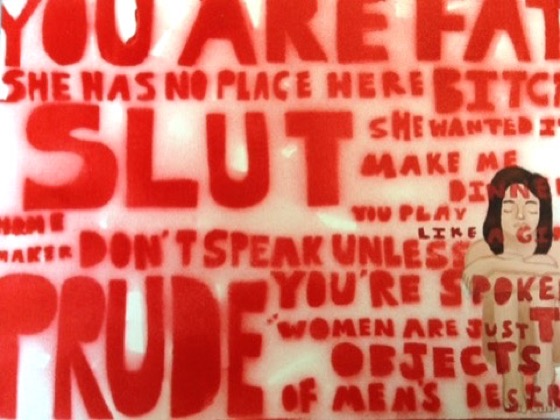
Our annual art show, which is held at the local cultural arts center, was two days away. The artwork to be displayed represented grades 9-12 and was matted, wired and delivered for hanging. The forms were all signed and the labels were all printed. I was thinking that this show would go off without a hitch. That was, until the phone rang.
Speaking from the other end of the connection was the cultural arts coordinator.
“Hi, Ian,” she began, in her polite, soft voice, “usually we don’t like to censor art but…”
I knew exactly what she was going to say. She would go on to explain the reasoning for pulling perhaps the most powerful piece out of the show. Here is a description of the work that was about to be censored in the artist’s words.
“To evoke the feeling of remorse and to provoke the viewer I decided to use stereotypes of women as seen in society today. The sayings and stereotypes imprison the girl. By doing this, I give the viewer a thought provoking point of view into society, a view many would rather ignore out of remorse and ignorance.”

Censorship Through History
Censorship is nothing new in the history of art. Pope Adrian VI described Michelangelo’s work on the ceiling of the Sistine Chapel as “a stew of naked bodies.” A few years later, a student of Michelangelo’s was set in charge of painting loin clothes and leaves to cover the naked figures in The Last Judgement. More recently, in the late 1980s, the U.S. Senate sought action to cut funding for the National Endowment for the Arts when photographer Andres Serrano created an image by submerging a plastic crucifix in a vat of urine.
The work being censored for our annual show wasn’t funded by the NEA and the establishment isn’t a church. However, the cultural arts center, as it was explained to me, is frequented by parents with small children. The coordinator believed this particular artwork might offend some of these visitors.
The Problem Areas
When creating art, there are several topics that are almost guaranteed to raise eyeballs. Here is a look at the level of controversy each may provide.
Nudity
Nudity would certainly be high on the list. However, with the exception of middle school boys, choosing this subject for an art piece is more likely to be attempted by the more mature student and examples would be few and far between.
Guns
The question of whether to censor an image of a gun can be a tough decision. Many circumstances, including the reason or purpose of the weapon in the image, the cultural background of the community, and the school or district’s policy, can all play a factor.
Language
In 1977, George Carlin made clear the “Seven Words You Can Never Say on Television”. Since that time, television standards have lessened and words once considered highly inappropriate are either now said or half-heartedly bleeped out. Unlike TV, art education circles still deem these words unsuitable. Furthermore, there are other words that are habitually spoken on television that may still be censored in a public art setting.
Social/Political Issues
The old saying goes, never talk about religion or politics. If artists followed this expression to the letter, there might not be any art at all. Taking a stand on a position is a perfectly acceptable reason to make art, but it comes with the predictable expectation of censorship.
So, what is an art teacher to do?
What can the art teacher do when students’ artwork is censored? In most situations, whether it is an administrator, a parent or a fellow teacher making the request, it is best to comply. Even if you know the art should stand, the battle may not be worth the consequences. Make sure you talk to your students and explain the situation so they understand. Then, look for other options such as private shows or contests that accept controversial subject matter for displaying the work.
Have you had a student’s work censored? What were the circumstances surrounding the request?
What did you do as a result of the censorship?
Magazine articles and podcasts are opinions of professional education contributors and do not necessarily represent the position of the Art of Education University (AOEU) or its academic offerings. Contributors use terms in the way they are most often talked about in the scope of their educational experiences.




